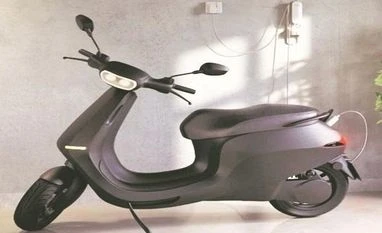On Independence Day, SoftBank-backed Ola is all set to disrupt the two-wheeler market with the launch of its highly-anticipated electric scooter.
It is, however, not the pioneer in this space. Hero Electric, Ather Energy, Bajaj Auto, and TVS have all been selling electric scooters but in small numbers —total sales were a mere 143,000 in FY21, a fall of 6 per cent.
But founder Bhavish Aggarwal’s four-pronged strategy marks a dramatic and bold shift. And the target is to grab half of the 20 million per annum two-wheeler market over the next few years.
Ola executives say they will bridge the price gap that has always existed between petrol and e-scooters (some peg it at Rs 7,000-10,000 even after subsidies, which have been increased by Rs 15,000 on a 3kwh scooter).
The second part of the strategy is the unprecedented scale. By 2022 its factory near Bengaluru will have the capacity to make 10 million units (half of all two-wheeler sales annually) and at least 2 million will be rolling in now. That will also account for 15 per cent of the world’s capacity of two-wheelers. And the investment of Rs 2,400 crore. Executives believe this will help reduce costs substantially.
Third, it will set up 100,000 quick charging stations across 400 cities in a year (you can charge half the battery in 18 minutes). Another concern over the distance such scooters can travel will also be addressed as Ola’s offering can do up to 150 km with one charge, thrice the average scooter usage in a day. To overcome the lack of a dealer network it is using an online booking system where delivery will be made at home.
Ola claims the response has been phenomenal — it received 100,000 bookings in a single day (at only Rs 499, which was refundable), and hopes at least 30 per cent will stay and take delivery. More importantly, it will supply the scooter to over 100 cities, so it will not be a staggered launch.
However, its competitors are not impressed and analysts are sceptical if this is an attempt to drum up valuations (Ola is set to go public and has seen its valuation drop to half by one of its investors).
Adds Harshvardhan Sharma, head – auto retail practice at Nomura: “The gradual migration from geared to gearless ATSC took almost a decade and it was not a big leap as compared to EV migration from ICE. For instance, the technicians who were servicing the geared scooters simply needed some re-skilling. But in the case of EVs the whole drive train is new. OEMs (original equipment manufacturers) and value chain players need more time for preparedness. Capacity does not equal sales.”
Differences
Ola and its competitors differ mainly on two points: The speed of market conversion to EV and whether the cost differential between ICE and e-scooters can be bridged.
The incumbents say the differential has not been bridged at all. Says Sudarshan Venu, TVS Motor’s joint managing director: “We are investing in technology and developing a portfolio of products. But as far as price parity is concerned, we estimate it will take another two years. We think customer adoption will determine the timing of large-scale move to EV.”
Right now, TVS is looking to scale production of the iQube manifold and is concentrating on cost reduction so that it can be gross margin positive by year end (it sells 1,000 units a month). "We are looking to play a leading role in this transition," said Venu. TVS has outlined an investment of Rs1000 crore for the EVs and plans to launch a new portfolio of two and three wheelers in the range of 5-25 kW within 24 months.
Meanwhile, Hero MotoCorp, the country’s largest two-wheeler maker, is readying to take on Ola. Managing Director Pawan Munjal has plainly said in interviews that he is ready to burn cash, and will raise funds if needed as his company is debt free, to ensure that his firm has leadership in two-wheeler EVs, too. And, he will commit 50 per cent of future investments to EVs.
Hero, which has put in place a 10-year EV plan, hopes to launch its own scooter by March, say sources. And to address the issue of charging, it is creating a large infrastructure through a tie-up with Taiwanese giant Gogoro, which has the largest battery swapping network. This will be supported by charging stations that Hero and Ather Energy (in which it has a stake and already sells its e-scooter) build across the country.
Ola’s other rival, Bajaj Auto, is unfazed. Its strategy is simple, unlike Ola it has no intention to force a change to EVs, but will go along with the market and sees it at around 3-4 million per annum in the next 3-4 years. After all, it has over Rs 16,000 crore of cash and can set up a mega factory in months, just like Ola has done.
Executive Director Rakesh Sharma says: “We are building a sustainable EV business and not selling scooters below cost by using central and state government subsidies, which could go away. So, we are focusing on technology and product development.”
The new battle in two-wheelers is just about to begin.
Unlock 30+ premium stories daily hand-picked by our editors, across devices on browser and app.
Pick your 5 favourite companies, get a daily email with all news updates on them.
Full access to our intuitive epaper - clip, save, share articles from any device; newspaper archives from 2006.
Preferential invites to Business Standard events.
Curated newsletters on markets, personal finance, policy & politics, start-ups, technology, and more.
)